5 Things to Know about Buying Gold & Silver Bullion for Retirement
Precious metals like gold and silver bullion can be a great part of a diversified retirement portfolio. AARP recommends assets of this nature should account for anywhere from 5 to 15 percent of your portfolio. But before you make any decisions, here are some tips to keep in mind about gold and silver bullion and retirement investments.
1. There’s Potential for Financial Security
During times of economic uncertainty, gold and silver bullion can provide added security. This can be an appealing extra “insurance policy” for times when your other retirement assets aren’t providing a significant payoff. Just be aware that such assets pay no dividends, and there are usually higher taxes on gains. But if you invest in gold and silver bullion wisely, it can provide protection against economic conditions involving:
• Disinflation and hyperinflation
• Deflation
• Stagflation
If you decide to include silver and gold in your portfolio, make sure to work with a reputable precious metals dealer such as First National Bullion. Scottsdale residents can rely on our professionalism and expertise when they’re ready to invest in gold and other precious metals for their retirement.
2. Gold Prices Can Fluctuate
Gold is sometimes referred to as the “currency of fear” because people tend to react emotionally and purchase it during economic downturns. This is why prices spiked during the 2008 recession and other times of economic uncertainty. The potential risk is that gold prices can go down as quickly as they go up. The good news is gold prices tend to rise when other aspects of the economy aren’t performing well, so things can balance out if the rest of your retirement portfolio is diverse and balanced.
3. Silver Is Cheaper but More Volatile
In general, silver bullion is cheaper than gold. However, silver’s price is more volatile than the price of gold. Its value is primarily based on the economy and the current demand for silver. It’s still worth considering as an investment resource during times when the demand is fairly consistent.
4. It’s Not Always Possible to Invest in Physical Gold/Silver
You can always purchase physical gold and silver bullion from a reputable dealer. However, few 401(k) plans permit physical investments in precious metals. Other options include buying stock in companies that mine gold or silver. You can also invest in gold or silver mutual funds. One other option is a precious metals IRA.
5. You Should Get Personalized Advice from a Financial Advisor or Accountant
You don’t want your entire retirement portfolio to consist of gold and silver bullion. However, if diversifying your portfolio this way is something you’re exploring, it’s a good idea to work with an accountant or other financial expert who can help you figure out the following details:
• How gold and/or silver bullion can fit into your existing retirement savings plan
• Whether or not it makes sense to consider these investments right now
• The potential risks you need to be aware of
• Any potential tax consequences you’ll need to consider
When they’re planning for retirement and looking for the best place to purchase gold and silver bullion, Scottsdale investors reach out to the trustworthy professionals at First National Bullion. We can answer all your questions and help you find all the information you need on how gold and silver can figure into your retirement planning decisions. Give one of our experienced dealers a call today at 480-546-8928.
The statements made in this blog are opinions, and past performance is not indicative of future returns. Precious metals, like all investments, carry risk. Precious metals and coins may appreciate, depreciate, or stay the same in cash value depending on a variety of factors. First National Bullion does not guarantee, and its website and employees make no representation, that any metals for sale will appreciate sufficiently to earn the customers a profit. The decision to buy, sell, or borrow precious metals and which precious metals to purchase, borrow, or sell are made at the customer’s sole discretion.


